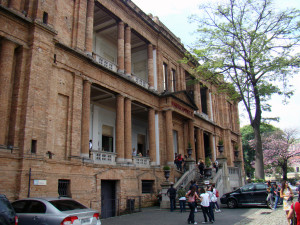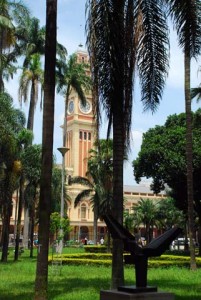
Photo: Rodrigo Soldon.
To the participants of the SciELO 15 years commemorating event, I start by indicating an amazing ride to Pinacoteca do Estado de São Paulo, located at Parque da Luz – or Jardim da Luz -, n. 2 – Tiradentes Avenue.
Visitors will have the opportunity to meet and enjoy one of the oldest Brazilian museums in the country, opened in 1905 and designed by Ramos de Azevedo (1851-1928) and Domitian Rossi (1865-1920). A museum, whose history is related to the School of Arts and Crafts of São Paulo (Liceu de Artes e Ofícios de São Paulo), created in the nineteenth century by Leôncio de Carvalho.

Parque da Luz. Photo: André Banyai.
The Parque da Luz or Jardim da Luz – as many residents use to name it – covers an area of approximately 113,000 m². The visitor, at first, can get to know the park that currently houses about 50 sculptures integrated into the collection of Pinacoteca. Then, beyond these outdoor sculptures, in the building of Pinacoteca, the visitor has the possibility to enjoy the exhibits that are quite revealing on the point of view of the artistic and cultural memory, that will certainly continue through next October, for example, what is about “Art in Brazil: a history at Pinacoteca Sao Paulo” (Arte no Brasil: uma história na Pinacoteca e São Paulo).
“Art in Brazil” offers a collection of 500 works distributed in eleven rooms, thereby named: “The colonial tradition”, ” Travelers artists “, “The creation of the Academy”, “The Academy at the end of the century”, “Academic teaching “, ” The genres of painting”, “Bourgeois realism”, “From the collections to the museum “, “An imaginary São Paulo” and “National in art”. It is about some history of Brazilian art in paintings, sculptures, drawings, prints, photographs… and, at the same time, a considerable portion of which was the formation of art in the country and the “creation of a national ideology in the arts”, from the colonial period to the mid-1930s.²
Another important exhibition at the same address reinforces the training aspect of Brazilian art, focusing especially on São Paulo, under the title: “The artistic São Paulo boarding in the Old Republic (1889-1930)”. The so-called “artistic boarding” existed “in the first version, introduced informally in the 1890s,” when artists could receive a scholarship for the purpose of education abroad in major art centers. And so were the commitment of sending these works to the government of São Paulo, which headed to the Museum Paulista (1895) and then to Pinacoteca do Estado (from 1905). The second phase of the then “boarding” occurred when creating a more formalized support to the “scholars from the fields of visual arts, music and singing in important artistic centers of Europe for improvement”.
It is curious to know the requirements to compete for such benefits were “being born in São Paulo, having between 12 and 25 years old and possess artistic vocation.”² What configured, clearly, a particular concern with planning the art collection in São Paulo.
Today, the collection of Pinacoteca has a total of 5000 works, most of them regarding Brazilian artists of the nineteenth century. The building underwent many renovations, and the most recent was in the ’90s, under the management of Emanoel Araújo (1940), which reformulation project was signed by architect Paulo Mendes da Rocha (1928).
* * *
In continuation to this visiting of the arts circuit at Pinacoteca until October, among other temporary exhibitions, I still mention the one entitled: “Two Times”, from the artist Gilberto Salvador, born in São Paulo in 1946.
This should be another approach opportunity to the visitor to get to know the art in Brazil from the ‘60s – and in the case of this artist – to the present day, with 24 of his works, including painting, objects and installations.
It is also worth mentioning that, besides the space at Pinacoteca, architect Gilberto Salvador had installed in 1999 in the Metro Station Jardim São Paulo, in the Northern district of Santana, the sculpture of his own named: “Voo de Xangô “3.
Incidentally, an appropriate monument that confers on the one hand, its timelessness relevance, especially in the São Paulo movement and on the other hand, the African-Brazilian culture marks expressed in the artistic representation of one of its deities1.
Notes
1 Shango, Sango or Shango Orisha is of Yoruba origin. To learn more about studies Orishas in Brazil, see, fundamentally: Candomblé in Bahia: Nago rite, Roger Bastide. Translation by Maria Isaura Pereira de Queiroz. São Paulo, Companhia das Letras, 2001 (revised and expanded edition). Candomblés of São Paulo, Reginaldo Prandi, São Paulo, and Hucitec Edusp, 1991. Also: Notes on The cult of the Orishas and Voduns, Pierre Verge, second edition, São Paulo, Edusp 2000.
Como citar este post [ISO 690/2010]:

















Recent Comments